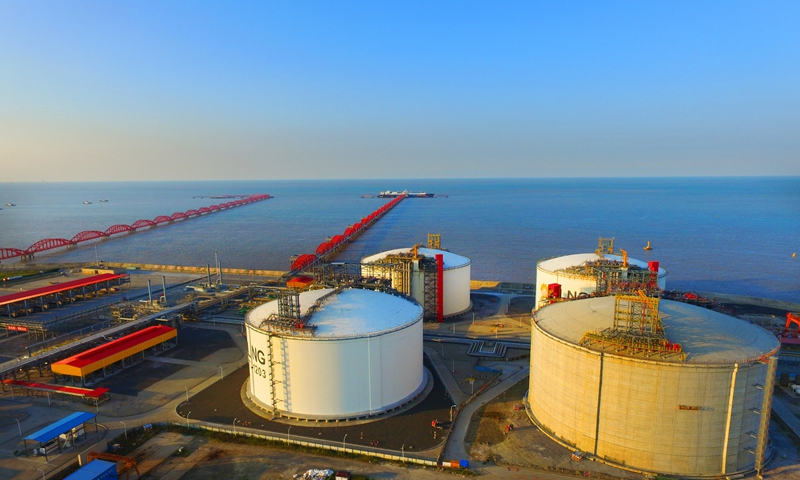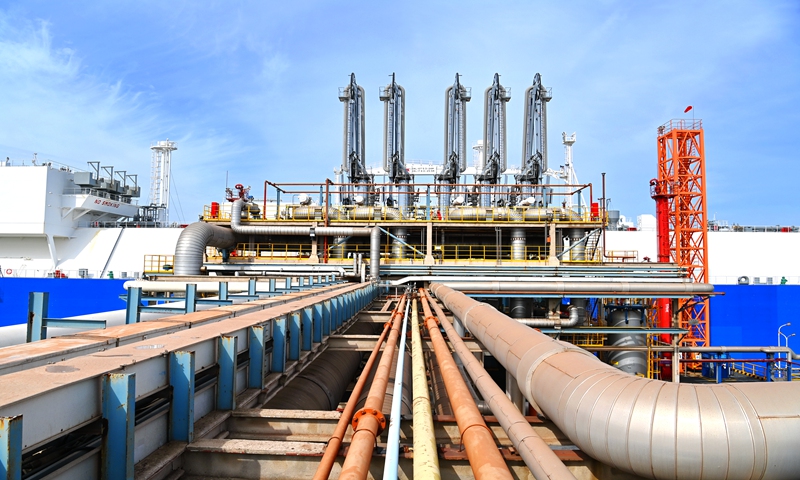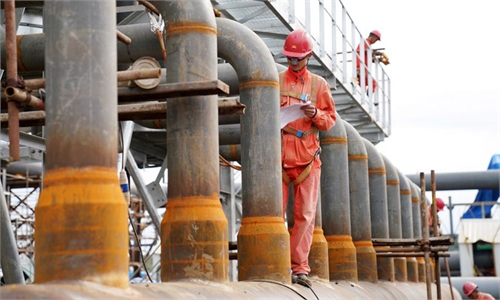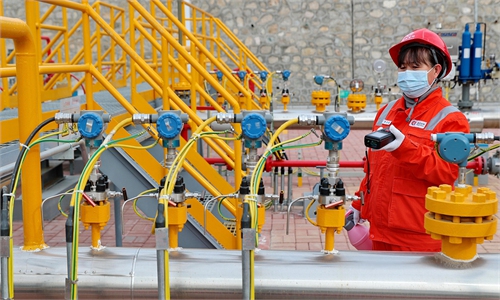Natural gas cooperation accelerated under the Belt and Road Initiative
Transition from fossil fuels to clean energy helps reach carbon neutrality

Photo shows the Jiangsu LNG Project of China National Petroleum Corporation at Yangkou Port, East China's Jiangsu Province. Photo: VCG
More natural gas import contracts have been signed or are likely to be signed over coming months between China and countries throughout the Belt and Road Initiative (BRI), as gas - one of the cleanest fossil fuels - acts as a bridge from using fossil energy to clean energy to reach carbon neutrality.
The latest example was two of the world's largest liquefied natural gas (LNG) modular facilities, which have set sail from Zhoushan, East China's Zhejiang Province on Thursday and will be delivered to Murmansk, Russia in 25 days, media reported.
LNG is natural gas that has been cooled to a liquid state at about -162 C for transport and storage.
In the future, 14 LNG modules, manufactured by six Chinese enterprises, will be assembled into the world's largest LNG production plant in Russia for the exploration and development of Arctic LNG, with a forecast annual production capacity of 6.6 million tons, media reported.
"For China, the development of the BRI natural gas projects can ease the domestic natural gas supply. At the same time, it is conducive to the diversification of overseas gas sources," Bai Wenxi, chief economist of IPG China, told the Global Times on Wednesday.
For countries along the Belt and Road, relevant projects can promote the development of natural gas resources, and promote the local social and economic development, Bai added.
China's natural gas consumption in the first half of this year reached 185.092 billion cubic meters, up 16.36 percent year-on-year, and is expected to reach 365 billion to 370 billion cubic meters in 2021, according to the Natural Gas Development Report released on Saturday by the National Energy Administration.
Last year's consumption stood at 328 billion cubic meters, while domestic production was 188.8 billion cubic meters, per statistics from the National Bureau of Statistics (NBS). This means that nearly 140 billion cubic meters of natural gas were sourced from overseas.
Natural gas imports
A ship carrying 65,000 tons of LNG from Papua New Guinea arrived at an LNG terminal in North China's Tianjin on Wednesday, marking 3.022 million tons of LNG delivered to the port this year, a historical high.
The terminal is operated by the China Oil and Gas Pipeline Network Corp (PipeChina), which is planning to build 17.6 kilometers of gas pipelines to boost connectivity across the integrated Beijing-Tianjin-Hebei region, media reported.

The second phase of LNG terminal of Sinopec Tianranqi Company has been completed in Qingdao, East China's Shandong Province on Tuesday. The LNG terminal's transfer capacity reached 7 million tons per year, equivalent to 9.6 billion cubic meters of natural gas. Photo: VCG
Another Chinese energy giant China National Petroleum Corporation (CNPC) is set to take delivery of a total of 51 billion cubic meters of natural gas from Turkmenistan's Galkynysh field under a three-year deal, media outlets reported on Tuesday.
Turkmenistan supplies annually 40 billion cubic meters of natural gas to China, which is the main export market for Turkmen gas, media reported.
LNG from Russia's Yamal plant was also delivered to China in June. CNPC received the first ship of Yamal LNG supplied to China in July 2018, media reported.
Meanwhile, in the year ended June 30, China became the largest buyer of Australia LNG for the first time. Shipments to China, which worth about $15.6 billion, totaled 30.7 million tons, up 7.3 percent year-on-year, according to report from consultancy EnergyQuest.
However, questions remains given Australia earlier canceled a BRI deal between Victoria and China, which the Chinese Embassy in Australia labeled "unreasonable and provocative", noting that the Chinese firmly opposed the move.
With the gradual upgrading of global energy transformation, the strategic position of natural gas resources is gradually rising, according to analysts.
Mounting demand, rising prices
As international natural gas prices continue to rise in 2021, it is important to diversify energy import sources and increase domestic supply, analysts said, noting that exploring other energy such as solar power and hydro power remain crucial components for China's energy security and reduction of carbon emissions.
The market price of LNG in China in the first ten days of August rose by 10.2 percent from the previous month, reaching 5,402.5 yuan ($833.2) per ton, while LNG price averaged at 2,500 yuan in 2020, according to NBS.
Gas prices have risen sixfold in Asia over the past year. US gas price also reached its highest level in a decade.
Analysts said the price hike is mainly driven by the shift in energy structure, as natural gas will gradually replace coal for carbon neutrality target. Natural gas, one of the cleanest fossil fuels, emits nearly 50 percent less carbon dioxide than coal.
"Strengthening natural gas cooperation with BRI countries can help accelerate the transition from using fossil energy to clean energy in China," Qiu Wenxu, director of Industry Development Department at the Alliance of Belt and Road Business Schools, told the Global Times on Thursday.
According to the International Energy Agency, total demand for natural gas in 2024 will increase by 350-430 billion cubic meters from 2020 levels.
By 2030, China's gas demand will reach 550-600 billion cubic meters. After that, it is estimated that natural gas consumption will reach a plateau around 2040, the National Gas Development Report noted.
Qiu also noted that China is now vigorously developing solar power, wind power and bio-energy to generate electricity as alternatives to fossil energy, so as to reduce the country's reliance on fossil fuels.



